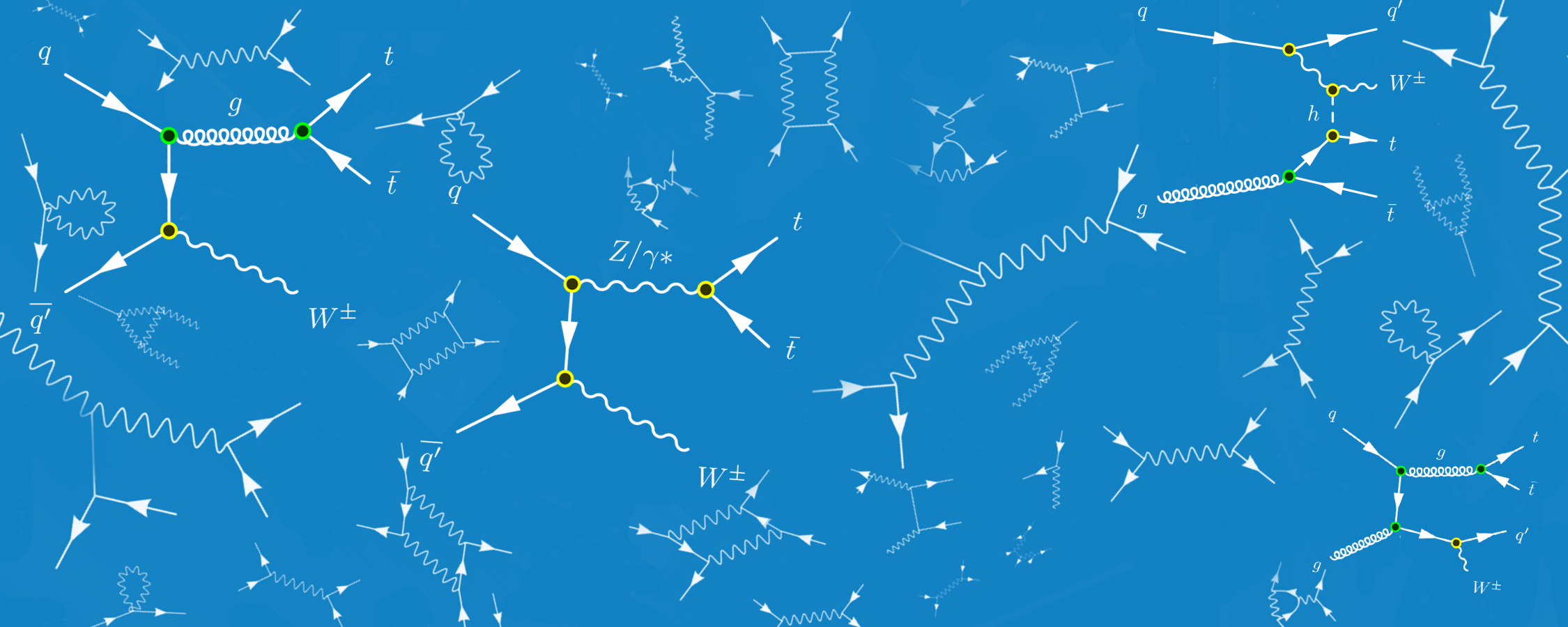ATLAS confirms mild tension in production of top-quark pairs with a W boson
24 March 2023 | By
The champion of the particle heavyweight division is the top quark, weighing in at 184 times the mass of the proton. The top quark was discovered nearly 30 years ago at the Tevatron collider by measuring a faint signal of top-antitop pair production (ttbar) in proton-antiproton collisions. Nowadays, ttbar is no longer a rare signal and over 200 million ttbar pairs were produced by the LHC during Run 2 (2015-2018). Instead, researchers at the ATLAS experiment are focusing on much rarer signals, such as the production of top-quark pairs alongside a W± boson (ttW). This process accounts for just 1 in every 1000 ttbar events.
As well as being an interesting process in its own right, ttW production is a major background process in several key ATLAS analyses, including top-pair-production with a Higgs boson (ttH, which probes the relationship between these heavy particles) and the simultaneous production of four top quarks (which offers a window into potential physics beyond the Standard Model). Curiously, all measurements of the inclusive ttW production rate (or cross section) by ATLAS and CMS have shown some over-abundance in data compared to theoretical predictions. This has made ttH and four-top searches very challenging, and spurred theorists to explore a myriad of effects that could account for this tension.
While a full understanding of the ttW tension has so far eluded physicists, it offers a useful test bed for subtle effects arising from quantum chromodynamics (which describes the interactions that bind quarks together). Top quarks can decay into leptons, which tend to fly away from the collision point preferentially in the direction of the incoming proton beam (leptonic asymmetry). Despite plentiful ttbar rates, measuring leptonic asymmetry at the LHC is very challenging due to the symmetry of the proton-proton collisions. However, studies of ttW provide an opportunity to do just that, as this asymmetry is enhanced by the production of the W boson alongside the ttbar pair.
The ATLAS Collaboration has released the most detailed analysis to date of the production of top-quark pairs alongside a W boson.
Today, at the Moriond conference (La Thuile, Italy), researchers from the ATLAS Collaboration at CERN presented the most detailed analysis of ttW production yet. They studied the wealth of data collected during Run 2 of the LHC (140 fb-1) to assess the forward-central lepton asymmetry of ttW production and give precise measurements of the ttW production rate (cross section). Among their results are the first differential cross-section measurements of ttW, a precise measurement of the total ttW cross section, and the ratio of the ttW+/ttW– cross sections. Researchers studied 9 kinematic observables that probe different physics effects in ttW production.
For these analyses, researchers studied collision events with 2 leptons of the same charge or 3 leptons with a total charge of ±1 produced alongside ‘jets’ of particles, some of which had to contain a hadron with a b quark (the calling-card of top-quark decays). These events are quite challenging to measure, as leptons from ttW decays are accompanied by undetectable neutrinos – making it difficult to tell which 2 of the 3 leptons came from the ttbar pair, an assignment required when measuring the forward-central asymmetry. Further, “non-prompt” leptons – which are produced from decays of hadrons away from the interaction point – are a challenging source of background. There are several types of non-prompt-lepton production, all leading to different detector interactions that are difficult to model from simulation alone.
To surmount these challenges, researchers estimated the background using a semi-data-driven method that relied on identifying control samples enriched in non-prompt leptons using a machine-learning algorithm. Further, they were able to account for effects related to the ATLAS detector’s resolution and particle-reconstruction efficiency using a statistical procedure called unfolding. Unfolding allows results to be directly compared to those of other experiments and to theoretical predictions. The specific unfolding method used in these analyses is exceptional, as it could be performed simultaneously with the background estimation.

The ATLAS Collaboration reported an observed leptonic asymmetry of −0.112 ± 0.170 (stat.) ± 0.054 (syst.), in good agreement with theoretical predictions. The inclusive cross section was measured to be 890 ± 85 fb, in agreement with predictions within 2 standard deviations (see Figure 1). This confirms the pattern of previous excesses in total ttW± production. The ratio of ttW+/ttW– was measured to be 1.95 ± 0.24, also consistent with the theoretical predictions.
Researchers also found that all measured kinematic observables and their relative ttW+ and ttW– contributions could be well-modelled by various simulations within uncertainties (see Figure 2), limiting the possibility that the ttW excess may be localised in a particular region of phase space. This result is critical input for the analyses in which ttW is a dominant background process, and will likely spur a new wave of interest in the theoretical models for ttW.
While these measurements present a major step forward in the understanding of the ttW process, they are limited by statistical uncertainties. New data from LHC Run 3 (2022-ongoing) will go a long way to improve this precision – strengthening ATLAS’ robust top-physics programme and potentially revealing new physics beyond the Standard Model.

Learn more
- Measurement of the total and differential cross-sections of tt¯W production in proton–proton collisions at 13 TeV with the ATLAS detector (ATLAS-CONF-2023-019)
- Search for leptonic charge asymmetry in tt¯W production in final states with three leptons at 13 TeV (arXiv:2301.04245, see figures)
- Moriond EW 2023 presentation by Lisa Shabalina: Top highlights from ATLAS
- CMS Collaboration: Measurement of the cross section of top quark-antiquark pair production in association with a W boson in proton-proton collisions at 13 TeV (arXiv:2208.06485, see figures)




